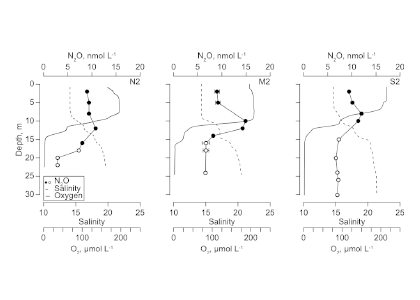Nitrous oxide (N2O) is a potent greenhouse gas with rising atmospheric concentrations. Atmospheric emissions of N2O are predicted to increase with continued anthropogenic perturbation of the nitrogen cycle, yet the magnitude of these emissions is uncertain, particularly in coastal systems where N2O fluxes are poorly constrained. How do N2O emissions from a eutrophic estuary vary in space and time?

Figure 1: Depth profiles of nitrous oxide (N2O) (circles), salinity (dashed line), and dissolved oxygen (solid line) in the Chesapeake Bay at three stations. Solid circles indicate oversaturation of N2O with respect to equilibrium with the atmosphere, and open circles indicate undersaturation.
In a recent publication in Estuaries and Coasts, Laperriere et al. (2018) examined how physical and biological processes influence the distribution of N2O in Chesapeake Bay using dissolved gas measurements (N2O and N2/Ar) and stable isotope tracer incubations. During stratified summer conditions, the mesohaline region of the Chesapeake Bay was always a source of N2O to the atmosphere. The highest N2O concentrations occurred in the pycnocline at the interface between reducing bottom waters and oxygenated surface waters (Figure 1). Vertical mixing of surface waters across the pycnocline caused elevated rates of ammonia oxidation, a biological source of N2O, and resulted in the accumulation of nitrite (NO2–) below the pycnocline. During periods of weak mixing, ammonia oxidation rates and N2O concentrations were lower, and low dissolved oxygen concentrations below the pycnocline set the stage for N2O consumption via denitrification (Figure 1). The interplay between biological and physical processes controlling fluctuations in N2O concentration was examined using a mass balance approach. Mass balance estimates indicated that both biological processes and physical transport contribute to local changes in N2O concentration. The authors suggest that the fate of N2O during stratified summer conditions is governed by vertical mixing across the pycnocline, controlling whether N2O is released to the atmosphere or consumed at depth.
Authors:
Sarah M. Laperriere (University of California, Santa Barbara)
Nicholas J. Nidzieko (University of California, Santa Barbara)
Rebecca J. Fox (Washington College)
Alexander W. Fisher (University of California, Santa Barbara)
Alyson E. Santoro (University of California, Santa Barbara)




